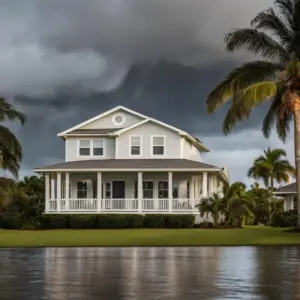Homeowners insurance is essential for protecting your home against unforeseen events. Understanding your policy—what it covers and what it excludes—is crucial to ensuring you’re adequately protected and avoiding unnecessary expenses. This guide will help you navigate your homeowners insurance policy by highlighting the importance of reading your policy documents, asking questions, and taking preventive measures to maintain your home.
What Your Typical Homeowners Insurance Policy Covers
Homeowners insurance policies typically cover a range of events, protecting you from significant financial loss. Common covered events  include:
include:
- Storms: Policies usually cover damage from hurricanes, windstorms, and other severe weather conditions.
- Hail Damage: Hail can cause significant damage to roofs, windows, and siding.
- Fire: Fire damage is one of the primary risks covered by homeowners insurance.
- Falling Objects: This includes damage from falling tree branches or other objects.
- Vandalism: Coverage for intentional damage caused by others.
Understanding these covered events is vital for ensuring your policy meets your needs. However, it’s equally important to know what is not covered.
Common Insurance Policy Exclusions
Not all damages are covered by homeowners insurance. Common exclusions include:
- Normal Wear and Tear: Insurance policies typically do not cover damages resulting from normal aging or usage of your home.
- Construction Defects: Issues resulting from poor construction practices are generally excluded.
- Foundation Failure: Structural problems with the foundation are often not covered.
- Pet and Animal Damage: Damage caused by pets or other animals is usually excluded.
- Mold and Fungus: Coverage for mold and fungus is often limited or excluded entirely.
Understanding these exclusions is crucial to avoid unexpected costs.
Examples of Normal Wear & Tear on Your Roof
One of the most common issues of normal wear and tear on Florida homes is your roof. The average shingle roof has a manufacturer-stated lifespan of 20 years. However, extreme weather conditions in Florida can reduce that lifespan. Common examples of wear and tear include:
- Aging Materials: Shingles that have naturally aged and deteriorated, such as becoming brittle, curling, or losing granules over time.
- Gradual Deterioration: Gradual breakdown of roofing materials due to exposure to the elements such as sunlight, rain, wind, and temperature changes.
- Minor Cracks and Leaks: Small cracks, leaks, or other minor issues that develop over time.
- Discoloration and Fading: Fading or discoloration of roofing materials due to prolonged exposure to the sun and weather conditions.
- Routine Maintenance Issues: Issues arising from a lack of regular maintenance, such as cleaning gutters, removing debris, and addressing small repairs promptly.
These issues, while common, are typically not covered by homeowners insurance. Regular maintenance is key to managing wear and tear.
The Importance of Reading Your Policy Documents
Southern Oak prides ourselves on our transparency and customer service for our policyholders. Whoever your insurance company is, when you receive your homeowners insurance policy documents, it’s essential to read them closely. By doing so, you agree to all the terms and conditions at the commencement of your policy and each year when it renews. Key reasons to read your policy documents include:
- Clarifying Coverage: Ensure you understand what is and isn’t covered so you’re not caught off guard when filing a claim.
- Identifying Exclusions: Know the limitations of your policy to plan for additional coverage if necessary.
- Understanding Responsibilities: Be aware of your obligations, such as maintaining your home to prevent damage.
If you have any questions about your policy, do not hesitate to ask your insurance agent for clarification. It’s their job to help you understand your coverage fully.
Preventative Measures: Routine Inspections and Regular Maintenance
Preventive measures and regular maintenance can save you significant money and hassle. Local roofing companies often offer free or low-cost inspections to help discover any trouble areas. Companies such as Stonebridge Roofing in North Florida offer yearly complimentary inspections to identify common trouble areas such as:
- Active Leaks
- Staining or Mold
- Sagging Roof Decks
- Clogged or Damaged Gutters
- Missing or Damaged Shingles
- Granule Loss
- Improperly Sealed Roof Penetrations (vents, skylights, etc.)
- Blocked or Inadequate Ventilation
- Moss, Algae, or Lichen Growth
Contacting a professional company like Stonebridge Roofing for routine inspections can help extend the lifespan of your roof, prevent larger issues later, and ensure coverage by completing preventative maintenance.
Cost Comparison: Roof Repair vs. Roof Replacement
In Florida, the average cost of roof repair for normal wear and tear ranges from $500 to $3000, depending on the extent of the damage. In contrast, the cost of a roof replacement for a 3000 sq. ft. house can range from $15,000 to $30,000.
Deductibles and the Cost of Ignoring Maintenance
Consider a $400,000 home with a typical 2% deductible. The deductible for a roof replacement would be $8,000. If an insurance claim is not covered due to pre-existing damage or conditions that were not maintained, you might be responsible for the entire cost of the replacement.
Ignoring regular maintenance and inspections can lead to significant financial burdens. It’s always more cost-effective to address issues as they arise and ensure your home remains in good condition.
Conclusion
Understanding your homeowners insurance policy is crucial to saving money and ensuring you’re adequately protected. By knowing what is covered and excluded, reading your policy documents carefully, asking questions, and performing regular maintenance, you can avoid costly surprises and keep your home in excellent condition. Regular inspections by professionals like Stonebridge Roofing can further ensure your roof’s longevity and reliability. Remember, a well-maintained home is not only a safe home but also a financially sound investment. If you’re still looking for quality home insurance coverage you can count on, you can request a quote here or search for one of our Southern Oak trusted agency partners.








